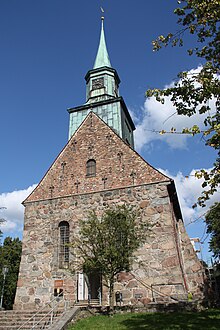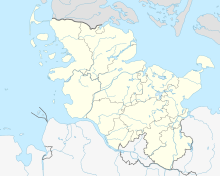St. Cyriacus (Kellinghusen)
St. Cyriacus is an Evangelical Lutheran stone church in Kellinghusen , Holstein.
history
According to legend, Ansgar founded a wooden church or chapel at this location. In addition to Schenefeld , Nortorf and Jevenstedt , Kellinghusen was one of the four Holstein Urkirchspiele . In 1154 the church was built by monks from the monastery founded by Vizelin in Wippendorf ( Neumünster ). According to entries in the Stellau church book, Pastor Bielefeld found a stone in the foundation wall of the tower in 1728, according to which the church was built in 1154 and consecrated to Cyriacus .
The church was first mentioned in 1196 and the first priest Johannes de Kelenghusen was attested. After the Reformation , Henricus Fischer was the first Evangelical Lutheran preacher in 1529. On June 26, 1686, lightning struck the church, whereupon it burned down to the church walls. It was able to be rebuilt and inaugurated in the same year. However, due to lack of money, the church remained without a tower until 1729.
In 1727 a renovation began, led by master builder Johann Georg Schott from Heide . In 1729 the nave was lengthened and the tower was rebuilt, with a golden cock on the top. At the same time the church received a new pulpit and a new altar.
From 1809 to 1839, the deacon Christian Kuss, known as a historian, worked . In 1879, Kellinghusen , which had previously belonged to the Rendsburg provost, was incorporated into the Rantzau provost by the new Schleswig-Holstein regional church. On July 25, 1929, the church burned down again, this time caused by a short circuit in the organ electrics. The entire baroque furnishings and the tower were destroyed, the stone walls were again preserved. In 1930 the church was rebuilt and consecrated on March 15, 1931.
Furnishing
Classic equipment
Due to the two fires in 1636 and 1929, no pieces of the old furnishings have been preserved in the church today. After the last fire, the church was furnished according to the prevailing taste of the time, so in 1935 it received four stained glass windows in the south wall from the workshop of Elisabeth Coester and in 1955 an oak baptismal font by the sculptor Otto Flath . The windows show various scenes from the life of Mary and Jesus together . Parts of the other equipment have been shown in an exhibition room in the tower since 2004. The largest are the foot of the old pulpit and the figure of Christ that hung in the chancel from 1930 to 1960.
Modern equipment
The church is known for its fully modern equipment, which was carried out in 1974 as part of a fundamental renovation of the interior. The redesign was carried out by Hans Kock , under whose direction the interior received a refreshing color in 1993, while at the same time the artistic design was completed.
Hans Kock saw the change in the interior as an overall concept that had to give "an answer to the [..] windows [of the south wall]". For the sanctuary he chose the motif of a wide sky over sunny golden hills that he wanted to be interpreted as the "land behind the cross, fields [...] of hoping faith". In the individual fields of the gallery on the north side, he contrasts the windows on the south side with strongly stylized, reflective and repetitive motifs with a Christian reference. Here again clouds, plus various variations of angel motifs, flowers, goblets and, in the center, the dove as a symbol of the Holy Spirit .
Bells
In 1728 a small bell was bought from Breitenburg Castle , but it broke after a short time. A large bell weighing 1,726 pounds was hung in the tower in 1788 and a smaller one in 1805.
The church received two new bells after the fire in 1929. One of them was donated by the North Elbian Women's Association, it bears the inscription Glory to God on high . It is still in the church today, while the other was melted down during World War II . In 1957, thanks to a donation, a second bell could be purchased. It bears the inscription Land, Land, Hear the Lord's Word . Also since 1929 there has been a mechanical church tower clock made by Korfhage & Söhne in the tower , the mechanics of which also control the chimes.
organ
1702–1730, the church had only a so-called positive , a non-portable small organ without pedals, to accompany the parish singing. In 1730 a used organ was bought from Gut Bothkamp , which was in service until the church burned down in 1929.
Today's organ was built in 1930–1931 by the organ builder Wilhelm Sauer . The pocket- shop instrument has 35 stops with around 2,500 pipes, two of which are transmissions , on three manuals and pedal, and is arranged romantically overall. The instrument has pneumatic actions that were electrified in 1960 by the Kemper company (Lübeck). The swelling device starts a pneumatically controlled swelling process that lasts about five seconds. The disposition is:
|
|
|
|
||||||||||||||||||||||||||||||||||||||||||||||||||||||||||||||||||||||||||||||||||||||||||||||||||||||||||||||||||||||||||||||||||||||||||||||||||||||||||||||||||||||||
- Coupling : I / II, III / I, III / II, I / P, II / P, III / P
- Playing aids: Hand register, three free combinations, two free pedal combinations, tutti, storage (tongues, roller, coupling), register crescendo roller
Photographs and map
Coordinates: 53 ° 56 ′ 57 ″ N , 9 ° 43 ′ 8 ″ E
See also
literature
- Ev.-Luth. Kirchengemeinde Kellinghusen (Ed.): The Sankt Cyriakus Church in Kellinghusen designed by Hans Kock . Self-published, Kellinghusen 2011.
- Karl-Heinz Roll, Ernst Gripp: St. Cyriacus Church in Kellinghusen. In: Heimatverband Kreis Steinburg (Hrsg.): Steinburger Jahrbuch 1997. Itzehoe 1996, pp. 224–239.
Individual evidence
- ↑ Information on the exhibition ( Memento of the original from October 14, 2011 in the Internet Archive ) Info: The archive link was automatically inserted and not yet checked. Please check the original and archive link according to the instructions and then remove this notice. in the tower on the website of the municipality. Retrieved November 7, 2012.
- ↑ Ev.-Luth. Kirchengemeinde Kellinghusen (Ed.): The Sankt Cyriakus Church in Kellinghusen designed by Hans Kock . Self-published, Kellinghusen 2011, p. 16 .
- ↑ Ev.-Luth. Kirchengemeinde Kellinghusen (Ed.): The Sankt Cyriakus Church in Kellinghusen designed by Hans Kock . Self-published, Kellinghusen 2011, p. 18 .
- ↑ Information on the organ ( Memento of the original from July 9, 2011 in the Internet Archive ) Info: The archive link has been inserted automatically and has not yet been checked. Please check the original and archive link according to the instructions and then remove this notice. on the municipality's website. Retrieved November 6, 2012.
Web links
- Church history on the parish website








